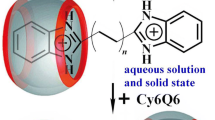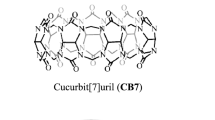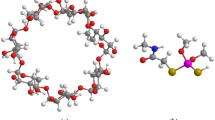Abstract
Inclusion complexes of ephedrine (EPh) with β-cyclodextrin (βCD), 18-crown-6 (18C6) and cucurbit[7]uril (CB7) were investigated using experimental and theoretical methods. The addition of βCD to the aqueous solution of EPh enhances the fluorescence emission spectrum at 312 nm. Whereas, the addition of CB7 and 18C6 cause enhancement of this band accompanied by growth of a band at around 412 nm. Electrospray ionization mass spectrometry, ESI-MS, results suggested that complexes of various stoichiometries are formed. The 1:1 complexes are the most dominant ones however, 1:2 (host: guest) stoichiometry and 2:1 (host: guest) stoichiometry for EPh with βCD and CB7 are also observed. The 1HNMR has indicated that EPh enters the CD hydrophobic cavity from the secondary rim and the aromatic ring is deeply inserted into the cavity with the ammonium ion left outside exposed to the aqueous solution. The molecular dynamics, MD, calculations show that EPh forms a stable complex with βCD and CB7 but not with 18C6. Furthermore, the ternary complexes of EPh–βCD with 18C6 and CB7 were found unstable according to the MD simulation studies, and ESI-MS experiments. The solid-state complexes prepared by freeze-drying and characterized by Fourier transform infrared spectroscopy and powder X-ray diffraction confirmed that only binary complexes are formed.














Similar content being viewed by others
References
Murray, J., Kim, K., Ogoshi, T., Yaod, W., Gibb, B.C., Yao, W., Gibb, B.C.: The aqueous supramolecular chemistry of cucurbit[n]urils, pillar[n]arenes and deep-cavity cavitands. Chem. Soc. Rev. 46, 2479–2496 (2017). https://doi.org/10.1039/C7CS00095B
Sherje, A.P., Dravyakar, B.R., Kadam, D., Jadhav, M.: Cyclodextrin-based nanosponges: a critical review. Carbohydr. Polym. 173, 37–49 (2017). https://doi.org/10.1016/j.carbpol.2017.05.086
Barrow, S.J., Kasera, S., Rowland, M.J., Barrio, J., del Scherman, O.A., Del Barrio, J., Scherman, O.A.: Cucurbituril-Based Mol. Recogn. Chem. Rev. 115, 12320–12406 (2015). https://doi.org/10.1021/acs.chemrev.5b00341
Assaf, K.I., Nau, W.M.: Cucurbiturils: from synthesis to high-affinity binding and catalysis. Chem. Soc. Rev. 44, 394–418 (2015). https://doi.org/10.1039/C4CS00273C
Yang, Z., Yao, X., Xiao, Z., Chen, H., Ji, H.: Preparation and release behaviour of the inclusion complexes of phenylethanol with β-cyclodextrin. Flavour Fragr. J. 31, 206–216 (2016). https://doi.org/10.1002/ffj.3302
Alonso, E.C.P., Riccomini, K., Silva, L.A.D., Galter, D., Lima, E.M., Durig, T., Taveira, S.F., Martins, F.T., Cunha-Filho, M.S.S., Marreto, R.N.: Development of carvedilol-cyclodextrin inclusion complexes using fluid-bed granulation: a novel solid-state complexation alternative with technological advantages. J. Pharm. Pharmacol. 68, 1299–1309 (2016). https://doi.org/10.1111/jphp.12601
Yang, K., Wan, S., Chen, B., Gao, W., Chen, J., Liu, M., He, B., Wu, H.: Dual pH and temperature responsive hydrogels based on β-cyclodextrin derivatives for atorvastatin delivery. Carbohydr. Polym. 136, 300–306 (2016). https://doi.org/10.1016/j.carbpol.2015.08.096
Wei, Y., Zhang, J., Zhou, Y., Bei, W., Li, Y., Yuan, Q., Liang, H.: Characterization of glabridin/hydroxypropyl-β-cyclodextrin inclusion complex with robust solubility and enhanced bioactivity. Carbohydr. Polym. 159, 152–160 (2017). https://doi.org/10.1016/j.carbpol.2016.11.093
Carmo, C.S., do, Maia, C., Poejo, J., Lychko, I., Gamito, P., Nogueira, I., Bronze, M.R., Serra, A.T., Duarte, C.M.M.: Microencapsulation of α-tocopherol with zein and β-cyclodextrin using spray drying for colour stability and shelf-life improvement of fruit beverages. RSC Adv. 7, 32065–32075 (2017)
Pal, K., Chandra, F., Mallick, S., Koner, A.L.: pH dependent supramolecular recognition of dapoxyl sodium sulfonate with 2-hydroxypropyl β-cyclodextrin: an application towards food-additive formulation. New J. Chem. 40, 6093–6100 (2016). https://doi.org/10.1039/C5NJ03415A
Pinho, E., Grootveld, M., Soares, G., Henriques, M.: Cyclodextrins as encapsulation agents for plant bioactive compounds. Carbohydr. Polym. 101, 121–135 (2014). https://doi.org/10.1016/j.carbpol.2013.08.078
Gokel, G.W., Leevy, W.M., Weber, M.E.: Crown ethers: sensors for ions and molecular scaffolds for materials and biological models. Chem. Rev. 104, 2723–2750 (2004). https://doi.org/10.1021/cr020080k
Sarma, M., Chatterjee, T., Das, S.K.: Ammonium–crown ether based host–guest systems: N–H⋯O hydrogen bond directed guest inclusion featuring N–H donor functionalities in angular geometry. RSC Adv. 2, 3920 (2012). https://doi.org/10.1039/c2ra20109g
Späth, A., König, B.: Molecular recognition of organic ammonium ions in solution using synthetic receptors. Beilstein J. Org. Chem. 6, 32 (2010). https://doi.org/10.3762/bjoc.6.32
Rüdiger, V., Schneider, H.-J., Solov’ev, V.P., Kazachenko, V.P., Raevsky, O.: Crown ether–ammonium complexes: binding mechanisms and solvent effects. Eur. J. Org. Chem. 1999, 1847–1856 (1999)
Doxsee, K.M., Francis, P.E., Weakley, T.J.R., Francis, P.E. Jr., Weakley, T.J.R., Doxsee, K.M. Jr.: Hydration, ion pairing, and sandwich motifs in ammonium nitrate complexes of crown ethers. Tetrahedron. 56, 6683–6691 (2000). https://doi.org/10.1016/S0040-4020(00)00487-7
Kryatova, O.P., Korendovych, I.V., Rybak-Akimova, E.V., Kryatova, O.P., Korendovych, I.V., Kryatova, E.V., Korendovych, I.V., Rybak-Akimova, E.V.: Complexes of benzo-15-crown-5 with protonated primary amines and diamines. Tetrahedron. 60, 4579–4588 (2004). https://doi.org/10.1016/j.tet.2004.03.080
Al-Burtomani, S.K.S., Suliman, F.O.: Experimental and theoretical study of the inclusion complexes of epinephrine with β-cyclodextrin, 18-crown-6 and cucurbit[7]uril. New J. Chem. (2018). https://doi.org/10.1039/c7nj04766e
Lagona, J., Mukhopadhyay, P., Chakrabarti, S., Isaacs, L.: The cucurbit[n]uril family. Angew. Chemie Int. Ed. 44, 4844–4870 (2005). https://doi.org/10.1002/anie.200460675
Liu, S., Ruspic, C., Mukhopadhyay, P., Chakrabarti, S., Zavalij, P.Y., Isaacs, L.: The Cucurbit[n]uril family: prime components for self-sorting systems. J. Am. Chem. Soc. 127, 15959–15967 (2005)
Moghaddam, S., Yang, C., Rekharsky, M., Ko, Y.H., Kim, K., Inoue, Y., Gilson, M.K.: New ultrahigh affinity host-guest complexes of cucurbit[7]uril with bicyclo[2.2.2]octane and adamantane guests: thermodynamic analysis and evaluation of M2 affinity calculations. J. Am. Chem. Soc. 133, 3570–3581 (2011). https://doi.org/10.1021/ja109904u
Cao, L., Šekutor, M., Zavalij, P.Y., Mlinaric̈-Majerski, K., Glaser, R., Isaacs, L., Sekutor, M., Zavalij, P.Y., Mlinaric-Majerski, K., Glaser, R., Isaacs, L., Mlinarić-Majerski, K., Glaser, R., Isaacs, L.: Cucurbit[7]uril × guest pair with an attomolar dissociation constant. Angew. Chemie Int. Ed. 53, 988–993 (2014). https://doi.org/10.1002/anie.201309635
Mueller, S.W., Maclaren, R.: Chap. 2 Vasopressors and inotropes. In: Hemmings, H.C., Egan, T.D. (eds.) Pharmacology and Physiology for Anesthesia, pp. 390–404. W.B. Saunders, Philadelphia (2014)
Kopysov, V., Makarov, A., Boyarkin, O.V.: Identification of isomeric ephedrines by cold ion UV spectroscopy: toward practical implementation. Anal. Chem. 89, 544–547 (2017). https://doi.org/10.1021/acs.analchem.6b04182
Pumera, M., Jelinek, I., Jindrich, J., Benada, O.: Β-Cyclodextrin-modified monolithic stationary phases for capillary electrochromatography and nano-hplc chiral analysis of ephedrine and ibuprofen. J. Liq. Chromatogr. Relat. Technol. 25, 2473–2484 (2002). https://doi.org/10.1081/JLC-120014268
Huang, W.X., Xu, H., Fazio, S.D., Vivilecchia, R.V.: Chiral separation of primary amino compounds using a non-chiral crown ether with beta-cyclodextrin by capillary electrophoresis. J. Chromatogr. B 695, 157–162 (1997)
Gingter, S., Ritter, H.: Chiral recognition of ephedrine: hydrophilic polymers bearing β-cyclodextrin moieties as chiral sensitive host molecules. Beilstein J. Org. Chem. 7, 1516–1519 (2011). https://doi.org/10.3762/bjoc.7.177
Wszelaka-Rylik, M.: Thermodynamics of β-cyclodextrin–ephedrine inclusion complex formation and covering of nanometric calcite with these substances. J. Therm. Anal. Calorim. 127, 1825–1834 (2017). https://doi.org/10.1007/s10973-016-5467-x
Suliman, F.O., Al-Burtomani, S.K.S.: Inclusion complexes of norepinephrine with β-cyclodextrin, 18-crown-6 and cucurbit[7]uril: experimental and molecular dynamics study. RSC Adv. 7, 9888–9901 (2017). https://doi.org/10.1039/C6RA28638K
Chen, W., Chang, C.E., Gilson, M.K.: Calculation of cyclodextrin binding affinities: energy, entropy, and implications for drug design. Biophys. J. 87, 3035–3049 (2004). https://doi.org/10.1529/biophysj.104.049494
El-barghouthi, M.I., Assaf, K.I., Rawashdeh, A.M.M.: Molecular dynamics of methyl viologen-cucurbit [n] uril complexes in aqueous solution. J. Chem. Theory Comput. 6(4), 984–992 (2010)
Assaf, K.I., Florea, M., Antony, J., Henriksen, N.M., Yin, J., Hansen, A., Qu, Z., Sure, R., Klapstein, D., Gilson, M.K., Grimme, S., Nau, W.M.: The HYDROPHOBE challenge: a joint experimental and computational study on the host-guest binding of hydrocarbons to cucurbiturils allowing explicit evaluation of guest hydration free energy contributions. J. Phys. Chem. B. 121, 11144–11162 (2017)
Kim, J., Jung, I., Kim, S., Lee, E., Kang, J., Sakamoto, S., Yamaguchi, K., Kim, K., Hyojadong, S., Korea, R.: New cucurbituril homologues: syntheses, isolation, characterization, and X-ray crystal structures of cucurbit [n] uril (n) 5, 7, and 8) smart supramolecules and Department of Chemistry Pohang University of Science and Technology Chemical. Anal. J. Am. Chem. Soc. 50, 31–36 (2000)
K, C.S., Maverick, B.Y.E., Seller, P., Schweizer, W.B., Dunrrz, J.D.: Acta Cryst. B36, 615–620 (1980)
Aree, T., Chaichit, N.: Crystal structure of beta-cyclodextrin-dimethylsulfoxide inclusion complex. Carbohydr. Res. 337, 2487–2494 (2002). https://doi.org/10.1016/S0008-6215(02)00335-X
Stewart, J.J.P.: Optimization of parameters for semiempirical methods VI: more modifications to the NDDO approximations and re-optimization of parameters. J. Mol. Model. 19, 1–32 (2013). https://doi.org/10.1007/s00894-012-1667-x
Morris, G.M., Goodsell, D.S., Halliday, R.S., Huey, R., Hart, W.E., Belew, R.K., Olson, A.J.: Autodock 4.2 (2009)
Boys, S.F., Bernardi, F.: The calculation of small molecular interactions by the differences of separate total energies. Some procedures with reduced errors. Mol. Phys. 19, 553–566 (1970)
Bowers, K.J., Chow, E., Xu, H., Dror, R.O., Eastwood, M.P., Gregersen, B.A., Klepeis, J.L., Kolossvary, I., Moraes, M.A., Sacerdoti, F.D., Salmon, J.K., Shan, Y., Shaw, D.E.: Scalable algorithms for molecular dynamics simulations on commodity clusters. In: Proceedings of the ACM/IEEE conference on Supercomputing (SC’06): p. 84., Tampa, Florida (2006)
Shaw, D.E.: Desmond Molecular Dynamics System, New York (2009)
Mokhtar, M.S., Suliman, F.E.O., Elbashir, A.A.: Experimental and molecular modeling investigations of inclusion complexes of imazapyr with 2-hydroxypropyl(β/γ) cyclodextrin. J. Mol. Liq. 262, 504–513 (2018). https://doi.org/10.1016/j.molliq.2018.04.088
Mura, P.: Journal of Pharmaceutical and Biomedical Analysis Analytical techniques for characterization of cyclodextrin complexes in aqueous solution: a review. J. Pharm. Biomed. Anal. 101, 238–250 (2014). https://doi.org/10.1016/j.jpba.2014.02.022
Álvaro-Muñoz, T., López-Arbeloa, F., Pérez-Pariente, J., Gómez-Hortigüela, L.: (1 R,2 S)-ephedrine: a new self-assembling chiral template for the synthesis of aluminophosphate frameworks. J. Phys. Chem. C. 118, 3069–3077 (2014). https://doi.org/10.1021/jp411124d
Bernardo-Maestro, B., Roca-Moreno, M.D., López-Arbeloa, F., Pérez-Pariente, J., Gómez-Hortigüela, L.: Supramolecular chemistry of chiral (1R,2S)-ephedrine confined within the AFI framework as a function of the synthesis conditions. Catal. Today. 277, 9–20 (2016). https://doi.org/10.1016/j.cattod.2015.10.010
Mokhtar, M.S., Suliman, F.O., Elbashir, A.A.: The binding interaction of imazapyr with cucurbit[n]uril (n = 6–8): combined experimental and molecular modeling study. Spectrochim. Acta A (2018). https://doi.org/10.1016/j.saa.2018.01.007
Uyar, T., Hunt, M.A., Gracz, H.S., Tonelli, A.E.: Crystalline cyclodextrin inclusion compounds formed with aromatic guests: Guest-dependent stoichiometries and hydration-sensitive crystal structures. Cryst. Growth Des. 6, 1113–1119 (2006). https://doi.org/10.1021/cg050500&%23x002B;
Lu, T.: Solid-state inclusion compounds of small amphiphilic molecules (C). New J. Chem. 29, 1335–1341 (2005)
Cunha-Silva, L., Teixeira-Dias, J.J.C.: How humidity affects the solid-state inclusion of 2-phenoxyethanol in β-cyclodextrin: a comparison with β-cyclodextrin. New J. Chem. 28, 200–206 (2004). https://doi.org/10.1039/b309491j
Li, S., Miao, X., Wyman, I.W., Li, Y., Zheng, Y., Wang, Y., Macartney, D.H., Wang, R.: High-affinity host–guest complex of cucurbit[7]uril with a bis(thiazolium) salt. RSC Adv. 5, 56110–56115 (2015). https://doi.org/10.1039/C5RA04468E
Li, S., Yin, H., Wyman, I.W., Zhang, Q., Macartney, D.H., Wang, R.: Encapsulation of Vitamin B1and its phosphate derivatives by cucurbit[7]uril: tunability of the binding site and affinity by the presence of phosphate groups. J. Org. Chem. 81, 1300–1303 (2016). https://doi.org/10.1021/acs.joc.5b02666
Buchelnikov, A.S., Hernández Santiago, A.A., Starodub, M.A., Mosunov, A.A., Parkinson, J.A., Evstigneev, M.P.: Generalized shape-independent approach to studying molecular hetero-assembly in solution using NMR diffusometry. J. Mol. Liq. 265, 88–95 (2018). https://doi.org/10.1016/j.molliq.2018.05.106
Kasprzak, A., Borys, K.M., Molchanov, S., Adamczyk-Woźniak, A.: Spectroscopic insight into supramolecular assemblies of boric acid derivatives and β-cyclodextrin. Carbohydr. Polym. 198, 294–301 (2018). https://doi.org/10.1016/J.CARBPOL.2018.06.085
Acknowledgements
The authors thank the Central Analytical and Applied Research Unit (CAARU) at College of Science for the technical support. SK-Burtomani would like to thank SQU for the leave of absence and for the financial support.
Author information
Authors and Affiliations
Corresponding author
Ethics declarations
Conflicts of interest
There are no conflicts of interest to declare.
Electronic supplementary material
Below is the link to the electronic supplementary material.
Rights and permissions
About this article
Cite this article
Al-Burtomani, S.K.S., Suliman, F.O. Deciphering ephedrine inclusion complexes with β-cyclodextrin, 18-crown-6 and cucurbit[7]uril using spectral and molecular modeling methods. J Incl Phenom Macrocycl Chem 93, 157–172 (2019). https://doi.org/10.1007/s10847-018-0866-1
Received:
Accepted:
Published:
Issue Date:
DOI: https://doi.org/10.1007/s10847-018-0866-1




